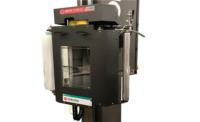SML Develops New Silage Cast Stretch Film

Cast film can contribute to easier bale wrapping and proper protection throughout the storage period. Image courtesy of SML
SML developed new formulations to manufacture high-quality silage film on its cast stretch film lines for bale wrapping. Silage films, typically made from blown films, preserve bales of silage, hay and maize. Wrapped around the bales, it prevents unwanted fermentation processes and maintains the nutritional value of the contents. To ensure easy bale wrapping and proper protection throughout the storage period, the quality requirements of these films are relatively high.
Compared with the manufacturing of blown silage film, this new approach offers some key advantages: higher output capacities, significantly lower production costs and the possibility to optimize the relevant film properties. Cast film can also achieve the right dart impact, cling level and oxygen permeability more easily than with blown film.
Low Oxygen Permeability Is Key
The market-conform value for the oxygen permeability of silage film should not be higher than 9,000 cm³/m²*24h. “Our major concern was the higher oxygen permeability of our cast film. In the past, a typical cast stretch film of 25 micron displayed a value above 10,000 cm³/m²*24h, whereas due to the latest development we achieved values of around 8,500 cm³/m²*24h,” says Thomas Rauscher, product manager at SML.
Keeping “Stickiness” High
Typically, silage film made on SML’s cast film line has at least five layers. Silage film for bale wrap features a layer that has to be at the outside of the roll and have high stickiness, whereas a standard cling level is between 5-10 N/m. The cling value of the PIB-free cast silage film was tested at 8-9 N/m and can produce the film with PIB in liquid as well as granule form, whereas the typical process is without liquid.
The high cling level can also be reached without PIB. This solution reduces the handling cost, since silage film on a PIB base normally needs to “rest” at least 48 hours in a heated storage room. “During the cast process, it is an easy task to put the cling material on the outer side of the roll. And we have several possibilities to guarantee a high stickiness,” says Rauscher.
“Slip Layer” With UV Protection
The layer on the other side of the silage film has to have a high slip. The slip layer helps to ensure that the wrapped bale does not get damaged during the stapling and storage process. As usual, the UV master batch is added to this layer. The UV additive protects the goods against damage caused by sunlight.
Dart Impact And Stretch Ability
The properties of the inner layers of the silage cast film guarantee the right dart impact and stretch ability. “The dart impact of silage films should be at least over 10 g/µm, while the tested cast films reached values of more than 15 g/µm,” says Rauscher. Silage film usually requires a stretch ability of between 50-100 %. “For a cast film, this is not an issue and so all the tests produced results exceeding the required stretch ability by far, based on 750mm wide rolls,” says Rauscher.
Higher Capacities, Higher Profitability
A roll width of 750mm is ideal for manufacturing silage cast film. The SML MiniCast manufactures 2 x 750mm rolls and the SmartCast delivers twice the output capacity of a state-of-the-art blown film line with its 4 x 750mm rolls. The higher production capability makes the manufacturing of silage film using the cast process much more cost-effective than on a line for blown film.
Raised Utilization Level
SML’s cast film lines manufacture conventional stretch wrap film, allowing manufacturers to raise the utilization rate of their extrusion lines further, which can have a favorable impact on the profitability.
Visit www.sml.at for more information.
Looking for a reprint of this article?
From high-res PDFs to custom plaques, order your copy today!






